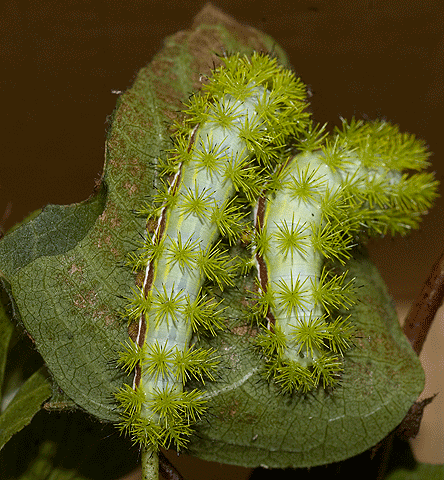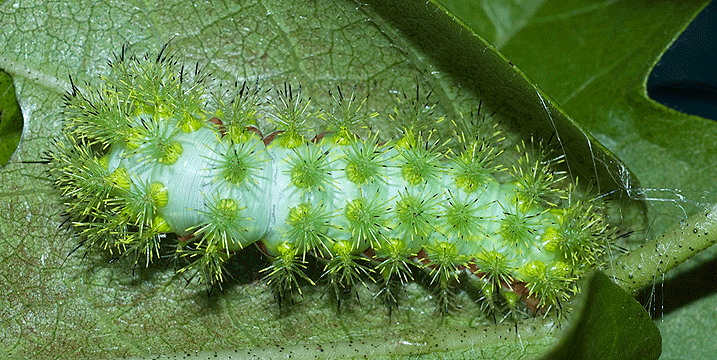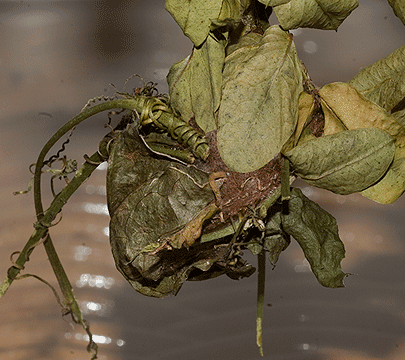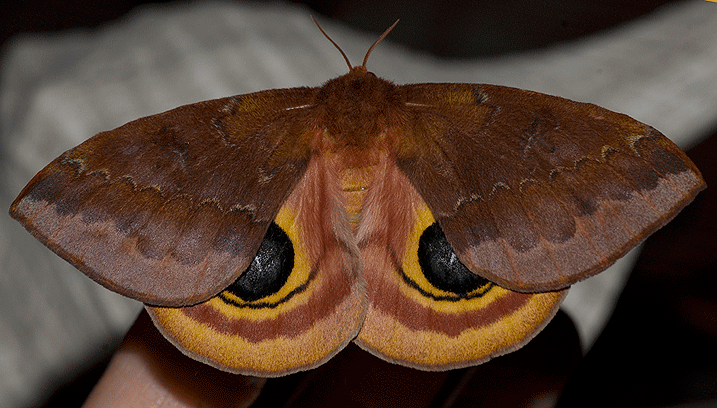IO Moth
Automeris io
IO Moth
Automeris io
Photographs by Susan Leach Snyder
In late December 2007, an Io moth laid her eggs on the wild cotton plant in garden 11. While working in the garden in early January, several horticulture volunteers spotted 9 caterpillars on the bottom of a single wild cotton leaf. When the leaf was moved, all of the caterpillars fell to the ground and scurried for cover. The volunteers were warned not to touch the caterpillars because of their venomous spines. Two caterpillars were captured and raised in an terrarium so they could be photographed and studied.
In the photographs below, the caterpillars are enlarged to show the spines. In the 2nd photograph below, note the silk threads attached to the leaf. The silk is used to secure the caterpillar to the leaf. Io moths are giant silkmoths and they spin silk cocoons; however, the silk is not the fine quality of the silk moth that is commercially bred for its silk.


Caterpillars have very simple eyes and chewing jaws.
At left, a caterpillar is chewing the leaf of the wild cotton plant. Io moth larvae can eat a variety of plants in addition to wild cotton, including maple, oak, willows, clover, corn, and ash.
The head end of this caterpillar is on the left. There are three pairs of jointed walking legs at the head end. The five pairs of prolegs toward the back of the caterpillar are not jointed; they function well in grasping.
The red and white lines on these caterpillars are very distinctive, and useful in identifying this species.
As these caterpillars continue to grow, they can get quite large.
Its defensive position is shown here. Curled in this way, a predator would probably leave it alone.
In late January, 2008 the two caterpillars in captivity crawled to a place in the terrarium to pupate.
Shown at right, a caterpillar began spinning a silk cocoon, using silk threads to pull leaves around its body. Shown below, the pupa is completely surrounded by leaves and very well camouflaged.

About 45 days later, one of the adult moths (shown in the next 5 photographs) emerged from its cocoon.
As shown above on the left, the hind wings of the Io moth have huge eyespots. With the wings open, the wingspan is about 3 inches. At rest (shown at right), the hind wings are covered and its wingspan is about 2 inches.
Two days after the first moth emerged, the second moth (shown in the next 3 photographs) emerged. Its color was more vivid.

In mid March, the day after each adult eclosed (emerged from the pupa stage), it was returned to the wild cotton plant, from which the caterpillars were collected. The sex of both moths is female. Males have feather-like antennae and are yellow.
Unlike adult butterflies, adult moths are most active at night. It is then that our two moths will feed, fly, and mate.
___________________________________
Links:
Index to Butterfly and Moth Visitors to the Conservancy Ecotone Trail
Index To Photographs of Plants in the Gardens
Conservancy of Southwest Florida Ecotone Home Page
Conservancy of Southwest Florida Home Page.
Please report errors to Susan Snyder at susanleachsnyder@gmail.com